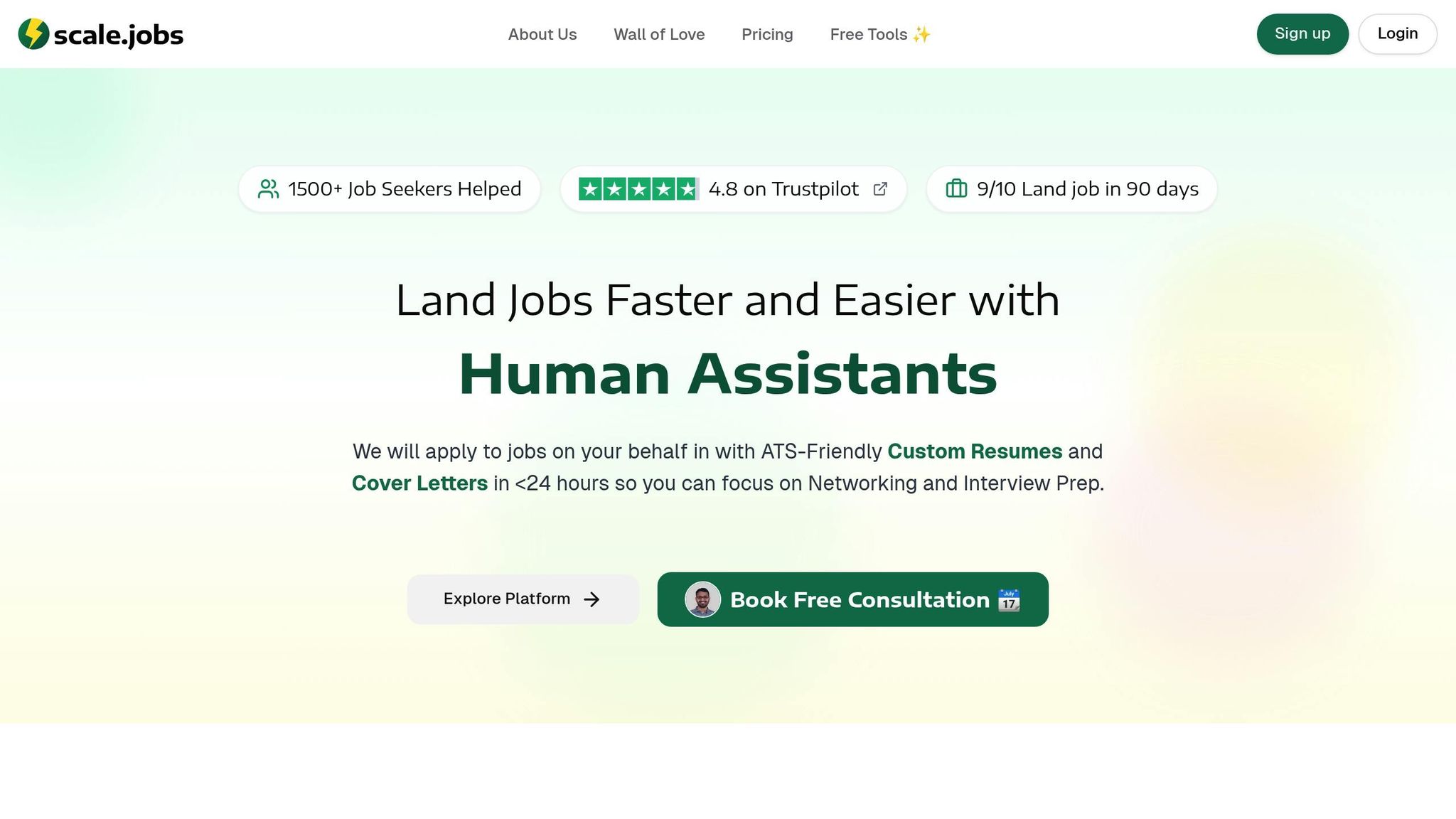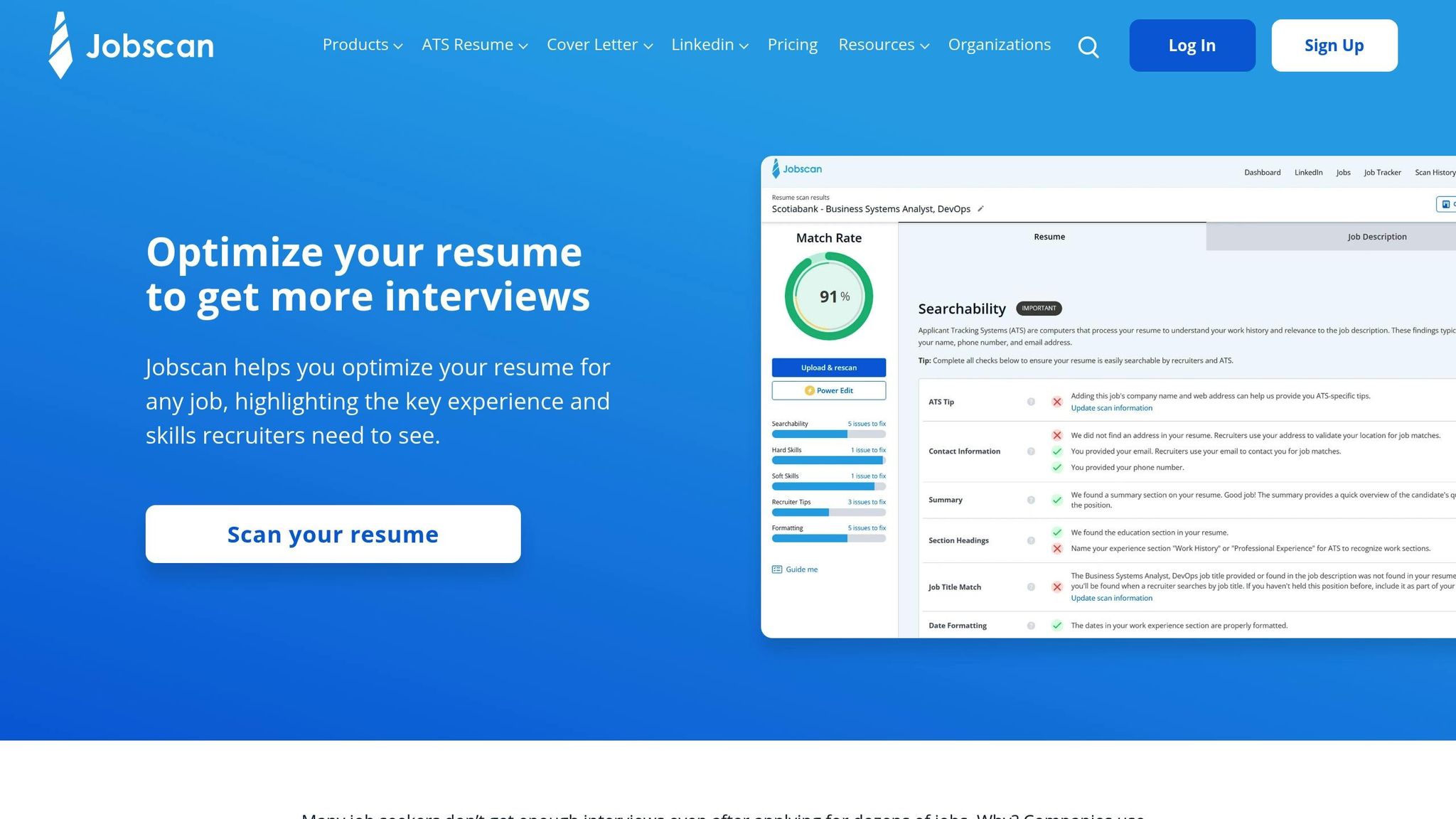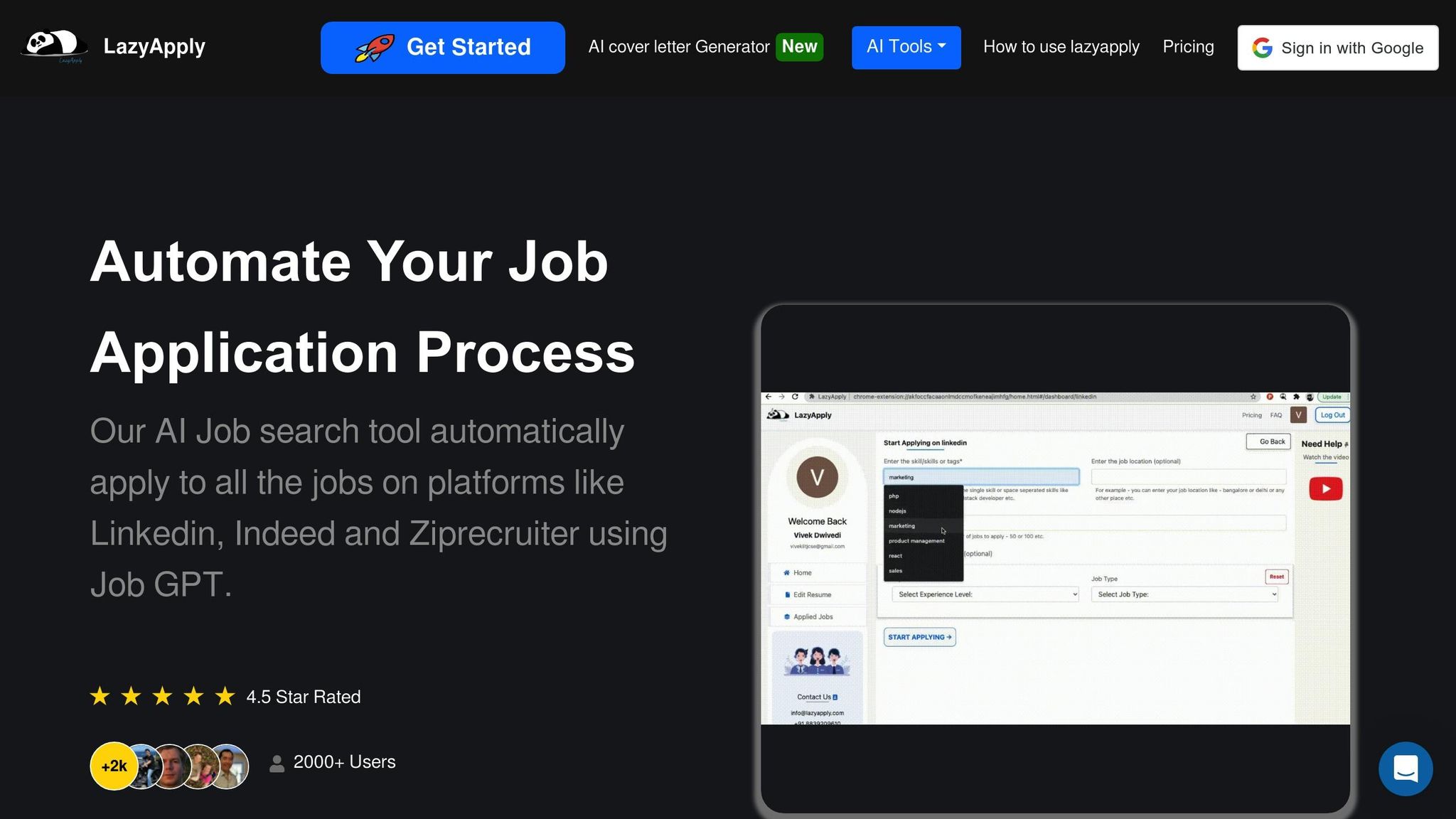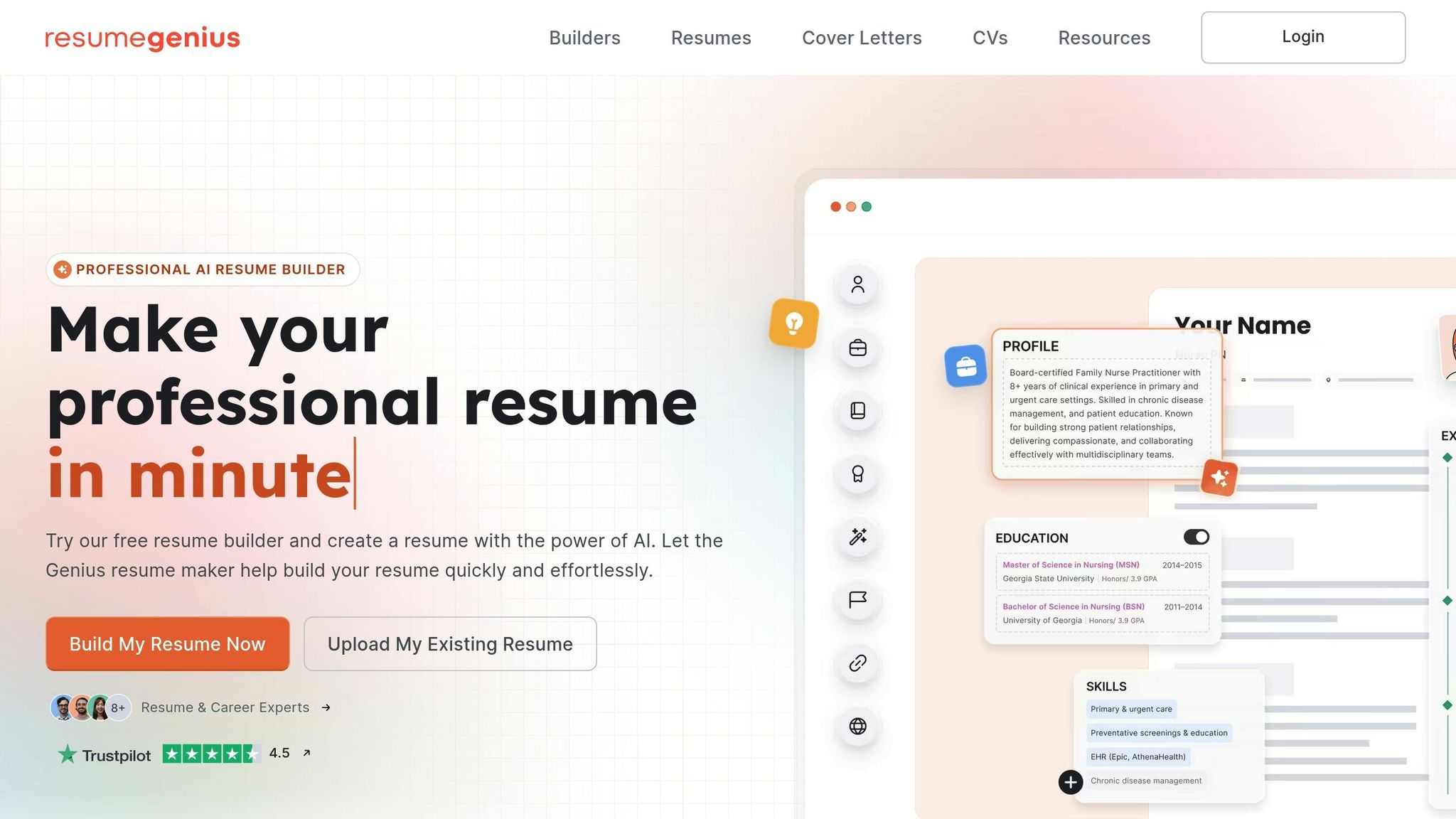Beat ATS Rejections Now: Human-Proof Your Application
scale.jobs
May 28, 2025
Did you know that 75% of resumes never make it past Applicant Tracking Systems (ATS)? If your resume isn’t optimized for both ATS algorithms and human recruiters, it’s likely to be filtered out before anyone even reads it. Here’s how to beat ATS rejection and get noticed:
- Understand how ATS works: ATS scans resumes for keywords, skills, and formatting. Complex designs, unusual fonts, or missing keywords can cause your resume to be skipped.
- Use ATS-friendly formatting: Stick to simple layouts, standard fonts like Arial or Calibri, and avoid graphics or tables that ATS can’t read.
- Optimize with keywords: Match the job description’s exact terms, especially for skills, job titles, and certifications.
- Show measurable achievements: Use the "What, How, Outcome" method to highlight results with numbers and impact.
- Balance ATS and human appeal: While ATS scans for keywords, recruiters look for clear storytelling and career progression.
Quick Tip: Use tools like resume checkers or services like scale.jobs to ensure your resume is ATS-compatible and human-friendly. Tailoring your resume for each job can increase your chances of getting an interview by over 10x.
This guide will teach you how to craft a resume that passes ATS filters and stands out to hiring managers.
ATS Resume Optimization: ATS-Friendly Resume Guide | Write an ATS-Optimized Resume That Gets Results
How Applicant Tracking Systems Work
To create a resume that stands out to both algorithms and hiring managers, it’s important to understand how Applicant Tracking Systems (ATS) function. Think of an ATS as a digital organizer - it doesn’t just store resumes; it actively scans and categorizes them. When you submit your resume, the system analyzes it by pulling out key details like your name, job titles, education, and skills. This process determines whether your application moves forward or gets lost in the system.
Here’s how it works: the ATS breaks your resume into searchable data points. It looks for your work experience, education, skills, certifications, and even your location. However, the technology isn’t foolproof. If your resume uses complex formatting, graphics, or unusual fonts, the system might misread or skip over important information.
Today’s ATS platforms are more advanced, often using AI and machine learning to evaluate, rank, and sort candidates based on how well they match the job description.
How ATS Score Resumes
More than 99.7% of recruiters use keyword filters in their ATS to identify candidates worth interviewing. These filters work much like search engines, scanning for specific terms that match the job requirements.
Recruiters focus on several key factors when filtering resumes. Skills top the list at 76.4%, followed by education (59.7%), job title (55.3%), certifications (50.6%), years of experience (44.3%), and location (43.4%). Structuring your resume around these priorities increases your chances of getting noticed.
| Filter Type | Usage Rate | What It Means for Your Resume |
|---|---|---|
| Skills | 76.4% | Match skill names exactly as they appear in the job ad |
| Education | 59.7% | Include degrees, certifications, and relevant courses |
| Job Title | 55.3% | Use the job title from the posting where applicable |
| Certifications | 50.6% | Highlight licenses and professional credentials |
| Experience | 44.3% | Quantify your years of experience in specific areas |
| Location | 43.4% | Mention your city, state, or willingness to relocate |
Using the exact job title from the posting can make a huge difference. Resumes that included the targeted job title received 10.2 times more interview requests than those that didn’t. Tailoring your resume to include the exact language and terminology from the job description - down to industry-specific buzzwords - gives you the best shot at passing ATS filters.
If your resume doesn’t include the right keywords, it might never even reach a recruiter’s desk. ATS systems can only process what they recognize, making keyword optimization absolutely essential.
While keyword optimization is critical for getting through the first round, human reviewers ultimately bring the context and judgment that technology lacks.
Why Human Review Still Matters
Even after passing through an ATS, your resume must impress human reviewers. At the end of the day, hiring decisions are made by people, not algorithms. The ATS’s job is to assist recruiters, not replace them. Resumes flagged by the system still undergo human review before moving forward.
But here’s the catch - ATS platforms have limitations. They rely heavily on keyword matching, which can overlook qualified candidates whose resumes don’t perfectly align with the job description. For example, an ATS might not recognize that a "Customer Success Manager" role aligns with a "Client Relations Specialist" position, but a human recruiter would.
These systems can also miss candidates with unique qualifications. Someone with strong leadership experience, for instance, might be ideal for a management role, even if their resume doesn’t include the exact keywords the ATS is programmed to flag.
Human reviewers add the nuance that ATS systems lack. They can evaluate career progression, interpret industry shifts, and assess soft skills that are hard to quantify. They’re also better at spotting potential, such as transferable skills or a candidate’s capacity for growth - qualities that algorithms simply can’t measure.
This creates a challenge: ATS platforms excel at identifying candidates based on past experience, but they often miss the broader picture of someone’s skills and potential. While the ATS prioritizes data, human reviewers consider storytelling, achievements, and how well a candidate might fit within the company’s environment.
To succeed in this two-step process, your resume must strike a balance. It should be technical enough to pass ATS filters but compelling enough to win over human decision-makers. By understanding how these systems work, you can craft applications that perform well at both levels, increasing your chances of landing that next big opportunity.
Making Your Resume ATS-Friendly While Keeping It Human-Readable
Crafting a resume that appeals to both applicant tracking systems (ATS) and human reviewers requires a careful balance. With over 75% of resumes rejected by ATS before reaching a recruiter, and hiring managers spending just 6 seconds on average scanning resumes, your approach needs to address both audiences effectively. The goal? Get past the ATS filters and make a strong impression on the person reviewing your resume.
Formatting for ATS Compatibility
The format of your resume plays a huge role in whether it gets past ATS systems. These systems often struggle with complex designs, so keeping it simple is key.
- Stick to a Word (.docx) format and basic fonts like Calibri, Arial, or Lato. While PDFs look polished, they aren't always ATS-friendly. Unless the job posting specifically asks for a PDF, go with a Word document to ensure compatibility. These fonts are also easy on the eyes for human reviewers.
- Use standard sections and margins. ATS systems are programmed to look for familiar headings like "Summary", "Work Experience", "Education", "Certifications", and "Skills". Avoid creative or unconventional section names that might confuse the system. Keep margins at one inch on all sides for proper scanning and readability on mobile devices.
- Avoid ATS-breaking elements. Tables, graphics, charts, and fancy fonts can cause errors in ATS parsing. Stick to clean, straightforward text formatting.
- Optimize for mobile viewing. Many hiring managers (62%) review resumes on smartphones or tablets. To ensure readability, limit bullet points to 60 characters and maintain a strong contrast between text and background colors (at least 4.5:1). Use proper heading levels to make your resume accessible for screen readers.
"Formatting matters more than content in the first 6 seconds! A perfectly qualified candidate with poor formatting will lose to a moderately qualified candidate with excellent formatting every time." - The Interview Guys
- Consider dual-column layouts, but prioritize key information. Modern ATS systems can handle dual-column designs, but place your most critical details - like contact information and core qualifications - in the left column for easy processing.
Once your formatting is clean and ATS-friendly, the next step is seamlessly incorporating the right keywords.
Using Keywords Effectively
Keywords are the link between your resume and the job description. Since 99.7% of recruiters use ATS keyword filters, using accurate and relevant terms is essential.
- Extract keywords directly from the job description. Pay attention to repeated terms, especially hard skills and technical qualifications. Including the exact job title in your resume can increase your chances of getting an interview by 10.6 times.
- Match the job description's language. If the posting mentions "project management", don’t use alternatives like "project coordination" or "project leadership." ATS systems evaluate exact matches and keyword placement. Small phrasing differences can affect your ranking.
- Integrate keywords naturally. Place the job title and key terms near the top of your resume to immediately highlight your fit for the role. Use the skills section to reflect the language of the job description, and weave keywords into your work experience bullet points to show how you've applied those skills.
- Focus on skills and technical terms. With 76.4% of recruiters filtering by skills, emphasize technical competencies, certifications, software expertise, and industry-specific terms. Use action verbs like "led", "developed", "analyzed", and "implemented" to highlight your contributions.
- Avoid keyword stuffing. Modern ATS systems evaluate context, so simply listing keywords won’t work. Instead, ensure your resume reads naturally. Skip overused buzzwords like "hardworking", "team player", or "go-getter" - these don’t add value.
After keywords, the most impactful way to stand out is by showcasing your achievements using a structured approach.
Showcasing Achievements with the WHO Method
Your achievements need to grab attention, and the WHO method - "What, How, Outcome" - is an effective way to turn generic job descriptions into powerful, measurable success stories. This approach not only incorporates relevant keywords but also demonstrates your impact.
- What: Define the task or challenge. Start with a strong action verb and clearly state what you accomplished. For example, instead of saying "responsible for training new employees", write, "initiated, wrote, and edited the first training manual for the company's data tracking system".
- How: Explain your approach. Detail the tools, methods, or strategies you used. For instance, "presented a proposal to use the manual to management" highlights leadership and process improvement.
- Outcome: Show the results. Numbers stand out to both ATS systems and human reviewers. Add metrics wherever possible, like "cut the training period in half, was adopted across the company, and is still in use today".
Linking your skills to measurable outcomes not only satisfies ATS requirements but also provides recruiters with concrete evidence of your abilities. Consistent date formatting (MM/YYYY) and well-structured achievement statements help ensure your resume tells a clear, compelling story.
scale.jobs vs. Leading ATS Tools: Why Human-Powered Wins

Expanding on the challenges of traditional ATS tools, let's dive into how scale.jobs stacks up against leading automated platforms. While automated tools often promise quick ATS optimization, they frequently fall short in crafting applications that genuinely connect with human recruiters. Here's how scale.jobs' human-driven approach outshines the competition.
scale.jobs vs. Jobscan: Human Precision Over Algorithms

Jobscan primarily relies on automated keyword scoring and ATS compatibility checks. While useful, this purely algorithmic method has its limits.
Why scale.jobs stands out:
- Storytelling that goes beyond keywords: Unlike Jobscan’s focus on keyword density, scale.jobs employs human experts to craft narratives that highlight your achievements and career growth.
- Real-time support via WhatsApp: Instead of static reports, scale.jobs provides live updates and assistance from dedicated professionals.
- Industry-specific insights: Human resume writers tailor applications based on current hiring trends and expectations, offering a level of detail and personalization that algorithms can't replicate.
- Soft skills and emotional intelligence: Human writers emphasize traits like leadership and teamwork, elements often overlooked by automated systems.
- Flat-fee pricing: While Jobscan locks users into recurring subscriptions, scale.jobs offers a one-time payment starting at $199 for up to 250 applications, with no hidden fees.
The human touch at scale.jobs ensures a level of precision and personalization that purely automated tools like Jobscan can’t achieve.
scale.jobs vs. LazyApply: Tailored Applications vs. Mass Submissions

LazyApply takes a bulk approach, using bots to submit hundreds of applications daily. Their pricing reflects this high-volume strategy, with plans ranging from $99/year for 15 daily submissions to $999/year for 1,500 daily submissions.
Why scale.jobs is the better choice:
- Avoiding spam filters: LazyApply's bot-driven submissions often trigger ATS spam filters, while scale.jobs’ human assistants manually complete each application, ensuring they pass through modern systems undetected.
- Quality over quantity: Instead of flooding employers with generic applications, scale.jobs creates tailored resumes and cover letters for each position.
- Personalized turnaround in 24 hours: Every application is carefully handled by trained assistants who align your career goals with job-specific requirements.
- Transparent tracking: Clients receive time-stamped screenshots of every application, ensuring complete visibility into the process.
- Higher ROI: LazyApply users may submit thousands of applications with minimal responses, whereas scale.jobs focuses on targeted, high-quality submissions that lead to better interview rates.
With scale.jobs, your applications are customized and positioned to engage real recruiters, avoiding the pitfalls of mass, bot-driven submissions.
scale.jobs vs. ResumeGenius: Customization vs. Templates

ResumeGenius operates on a subscription model, charging $7.95 monthly (billed annually at $95.40). However, many users report feeling misled by subscription practices and face challenges when trying to cancel.
Why scale.jobs outperforms ResumeGenius:
- Tailored resumes for every job: ResumeGenius relies on fixed templates that require manual edits, while scale.jobs creates fully customized, ATS-optimized resumes for each role.
- No recurring fees: With scale.jobs’ one-time payment model, you avoid the ongoing costs and cancellation headaches typical of subscription services.
- Comprehensive application management: Beyond resumes, scale.jobs handles cover letters, application submissions, and tracking across multiple job portals - services ResumeGenius doesn’t provide.
- Human expertise over DIY: Instead of leaving you to figure out ATS optimization, scale.jobs assigns professionals who stay updated on hiring trends and employer expectations.
- Clear, upfront value: The flat-fee structure eliminates the need for continuous payments, delivering results without the burden of recurring charges.
Tools and Resources to Improve Your Job Applications
Turn your job hunt into a focused, strategic effort instead of a scattershot numbers game. While scale.jobs provides hands-on support with human assistants, knowing the right tools can help you refine your approach and improve your chances of success. These resources work alongside scale.jobs’ personalized services to ensure every application is polished, tracked, and aligned with your goals.
Free ATS Optimization Tools from scale.jobs
Scale.jobs offers a suite of free tools designed to improve your job search experience. The Resume ATS Checker and Actionable Feedback Engine analyzes your resume against specific job descriptions, pinpointing keyword gaps and formatting issues that could prevent it from passing Applicant Tracking Systems (ATS). Unlike simple keyword tools, this feature gives precise recommendations to make your resume more effective.
The Cover Letter Generator creates personalized cover letters based on the job requirements and your experience. Meanwhile, the Job Applications Tracker, supported by scale.jobs' human assistants, helps you keep tabs on your applications across various platforms. For salary discussions, the Salary Predictor offers data on market rates, and the Interview Questions Predictor prepares you for role-specific questions.
If you need to showcase your work, the Portfolio Website Generator is a valuable tool. For instance, Margaret, a Social Media Manager at S'well, stood out in her job search by creating a portfolio featuring photos and videos of S'well bottles around the city. Though she admits the visuals weren’t flawless, her effort demonstrated her passion and creativity, setting her apart from other candidates.
"In the end, people are just looking to hire passionate people. And if you go the extra mile, I think it'll work to your benefit." - Margaret, Social Media Manager at S'well
These tools not only enhance your resume and cover letter but also provide ways to validate your skills with real-world examples.
Using Proof-of-Work Examples
Proof-of-work examples, like portfolios, showcase your ability to achieve measurable results. These are especially impactful in competitive job markets. While portfolios are often associated with creative roles, they can benefit professionals in fields like sales, marketing, project management, and even administration.
"A work portfolio is a collection of your work experience along with work samples that showcase your talents into one cohesive bundle." - Career Contessa Team
To make your portfolio stand out, include specific metrics - numbers, percentages, or dollar amounts. For example, instead of saying "increased social media engagement", you could write, "boosted Instagram engagement by 340% over six months, generating $50,000 in additional revenue." If you’re early in your career, you can include academic projects, volunteer work, or personal initiatives to highlight your skills and resourcefulness.
Today, digital portfolios - whether hosted on a website or formatted as PDFs - are the norm. They allow you to include multimedia elements like videos, interactive designs, or code samples. The key is to provide context for each piece: explain the challenge, your approach, and the results. This narrative helps potential employers see not just what you accomplished, but how you think and solve problems.
At the same time, tracking your applications ensures you’re building a smarter strategy.
Tracking and Improving Application Results
Keeping track of your applications can transform a chaotic job search into a well-organized, data-driven process. Modern tools let you monitor the status of applications, set follow-up reminders, and identify patterns in your job search. This helps you avoid duplicate submissions, missed opportunities, or ineffective strategies.
In March 2023, David Chong, a Software Engineer at Microsoft, used Huntr to streamline his job search. By tailoring his resume to each position and keeping his applications organized, he saw a significant improvement in response rates. This allowed him to focus more on interview preparation than administrative tasks.
"Huntr helps you create tailored resumes and cover letters fast with AI, fill out application forms in one click, and automatically organize your job search." - Huntr
Data also reveals useful trends. For example, resumes that include the exact job title in the header are 10.6 times more likely to get interview requests. Tracking tools like these provide actionable insights that can refine your approach over time.
Scale.jobs combines human expertise with systematic tracking. Their virtual assistants provide time-stamped screenshots of every application submission, giving you a transparent record of your efforts. This documentation helps identify which roles and companies are most responsive to your background, making it easier to adjust your strategy and focus on opportunities that align with your strengths.
Getting Your Next Job with ATS-Friendly, Human-Focused Applications
If you're aiming for your next role, your resume needs to perform double duty: pass through Applicant Tracking System (ATS) filters and impress real people. With 99% of Fortune 500 companies using ATS software and 99.7% of recruiters relying on keyword filters to sort applications, your approach must balance technical precision with human appeal. Services like scale.jobs simplify this process, helping you bridge the gap between automated systems and personal connections.
The key lies in crafting a resume that combines technical accuracy with engaging storytelling. While ATS software screens for formatting and keywords, human reviewers look for measurable achievements and narratives that make candidates stand out. To succeed, your application must highlight your accomplishments with specific numbers and tell a story that resonates with hiring managers, all while meeting the technical criteria to pass the initial filters.
Scale.jobs takes the guesswork out of this process by offering personalized support. Their human assistants ensure that every resume and cover letter is optimized for ATS while still appealing to recruiters. For those who want to spend more time networking and preparing for interviews, this service can manage the entire application process. By reducing the average job search time from 5 months to just 1–3 months, it frees you up to focus on the tasks that truly set you apart from other candidates.
This dual strategy - navigating digital systems and connecting with decision-makers - can streamline your job search and give you an edge in a competitive market.
FAQs
How can I make sure my resume works for both ATS software and human recruiters?
To make sure your resume works well for both ATS software and human recruiters, keep the design simple and straightforward. Avoid using tables, graphics, or unusual fonts that might confuse ATS systems. Stick with standard headings like Work Experience and Education so the software can easily understand your information. Also, include keywords from the job posting to ensure your resume aligns with ATS filters.
When it comes to human recruiters, focus on crafting clear and concise bullet points that showcase your accomplishments. Highlight measurable achievements and keep the layout organized and easy to read. This way, your resume not only passes automated screenings but also grabs the attention of hiring managers.
What common resume formatting mistakes can cause ATS rejection, and how can I avoid them?
To make sure your resume gets through Applicant Tracking Systems (ATS) smoothly, steer clear of these common formatting pitfalls:
- Complicated Layouts: Avoid using tables, text boxes, images, or graphics. These elements can confuse ATS software. Stick to clear section titles like "Work Experience" and "Education" for easy navigation.
- Inconsistent Date Formats: Pick one date format and stick to it throughout your resume. For example, use either "March 2023" or "03/2023", but don’t mix them.
- Unusual Fonts: Stick with standard, easy-to-read fonts like Arial, Calibri, or Times New Roman to ensure your resume is clear and professional.
- Key Details in Headers or Footers: ATS systems often skip over headers and footers, so make sure critical information is included in the main body of your resume.
- Wrong File Formats: Save your resume as a .docx or .pdf file. These formats are widely accepted and work best with ATS software.
Following these tips will increase the chances of your resume passing ATS scans and catching the attention of hiring managers.
Why is it important to use exact keywords from the job description in my resume?
Using the exact keywords from a job description can make or break your chances of getting noticed. Why? Because Applicant Tracking Systems (ATS) are programmed to scan resumes for terms and phrases that directly match the job posting. If those keywords are missing, your resume might never make it to a recruiter's desk.
By mirroring the language used in the job description, you’re not only improving your odds of passing the ATS filters but also showing recruiters that you’re aligned with the role’s requirements. It’s a simple yet powerful way to ensure your application stands out to both the software and the human reviewing it.
Related posts
Land Jobs Faster and Easier withHuman Assistants
We will apply to jobs on your behalf with ATS Friendly Custom Resumes and Cover Letters in < 24 hours, so you can focus on Networking and Interview Prep.